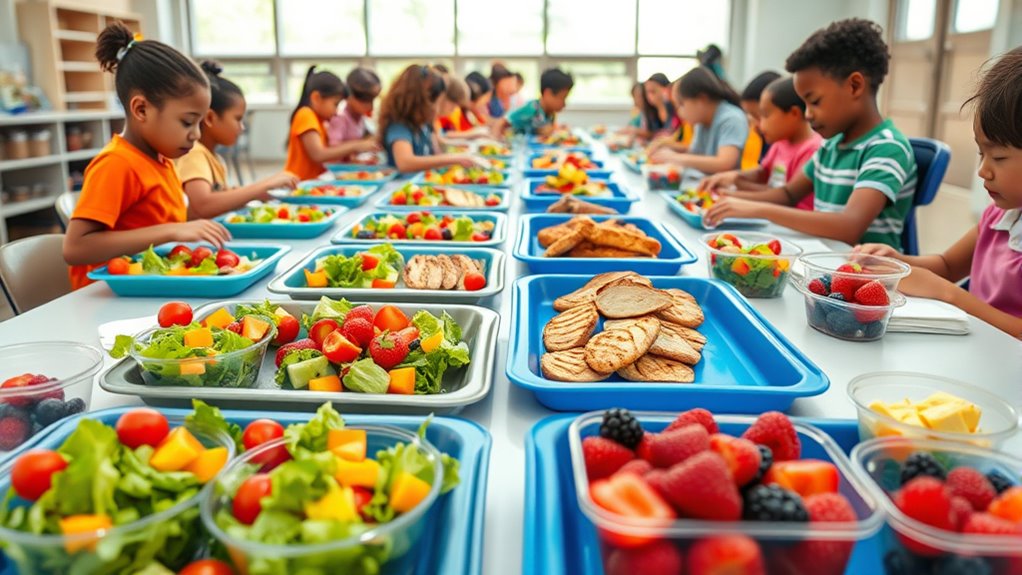Starting in 2026, new nutrition standards will reshape school lunches by focusing on precise portioning that guarantees balanced, nutrient-rich meals while minimizing waste. Funding policies will support menu diversification with appealing fruits, vegetables, and lean proteins, all made possible by enhanced kitchen equipment and high-quality ingredients. Advanced technology will help monitor portion sizes and provide real-time nutritional info to students. To discover how these changes will impact schools and students, keep exploring further.
Key Takeaways
- New nutrition standards for 2026 emphasize balanced portions tailored to age, activity, and dietary guidelines.
- Funding policies support menu diversification and sourcing higher-quality, nutritious ingredients for school meals.
- Technology integration enables real-time nutritional information and consistent portioning across schools.
- Strategies focus on reducing waste while promoting nutrient-dense, appealing meal options for students.
- Behavioral and informational tools encourage healthier eating habits, ensuring compliance with upcoming standards.

Schools across the country are revamping their lunch programs to better meet students’ tastes and nutritional needs. One of the key changes you’ll notice involves meal portioning, which is now being carefully adjusted to guarantee students receive adequate nutrition without excess waste. The new standards aim to strike a balance between offering enough food to satisfy hunger and promoting healthier eating habits. Instead of serving large, uniform portions, schools are now adopting more flexible meal portioning strategies that consider age groups, activity levels, and dietary guidelines. This approach helps reduce food waste and encourages students to eat balanced meals that fuel their bodies and minds. Incorporating nutritional standards into menu planning ensures that meals align with health guidelines and support student well-being. Funding policies play a critical role in implementing these changes. Schools are steering through new financial constraints and opportunities, which influence how they can allocate resources toward healthier ingredients and better meal planning. Federal and state funding policies are increasingly favoring initiatives that promote nutrition education and access to fresh, wholesome foods. As a result, schools are receiving more support to upgrade their kitchen equipment, source higher-quality ingredients, and train staff on preparing nutritious meals. These policies also influence the size and composition of meal portions, ensuring that budgets align with nutritional standards. You might wonder how these policies impact your child’s lunch experience. Schools are now more focused on delivering meals that meet strict nutritional standards while staying within funding limits. This means careful planning and budgeting are necessary to include a variety of fruits, vegetables, whole grains, and lean proteins. Additionally, technology and data tracking are being increasingly used to monitor and optimize meal quality and portion sizes, making the process more efficient. Implementing standardized portioning methods can help ensure consistency and fairness in meal distribution across different schools. Integrating behavioral insights can further encourage healthier eating habits among students, leading to better nutritional outcomes. Moreover, some districts are experimenting with digital menu boards to provide real-time nutritional information, which can motivate students to make healthier choices. The funding policies also encourage schools to innovate with menu options, offering more diverse and appealing choices that cater to students’ tastes. While some may worry about costs, many schools are finding that investing in better meal portioning and nutritious ingredients actually reduces waste and saves money in the long run.
Frequently Asked Questions
How Will These Standards Impact School Lunch Budgets?
You might face budget implications as these new standards require more nutritious ingredients, which could increase costs. These funding challenges mean you’ll need to find ways to balance quality and expense, possibly cutting back elsewhere or seeking additional support. While healthier meals benefit students, you should prepare for potential financial adjustments, ensuring your school can meet these standards without compromising other programs or overextending your budget.
Are There Exemptions for Certain Schools or Districts?
You’ll find that there are some school exemptions and district flexibility allowed under the new standards. Certain schools or districts with unique challenges can apply for waivers or modifications, giving them some leeway in meeting specific nutrition requirements. This flexibility helps guarantee that all students still receive nutritious meals without overburdening districts facing resource or infrastructure constraints, making the standards adaptable to diverse school needs.
How Will Students’ Food Preferences Be Considered?
Did you know that nearly 75% of students want healthier options? You’ll see that your food preferences are a priority, with efforts to incorporate student taste preferences into menu diversity. Schools are encouraged to offer more appealing, varied meals, respecting your likes while meeting nutrition standards. This approach aims to increase participation and make sure you enjoy your lunch while staying healthy.
What Training Will Staff Receive for New Standards?
You’ll find that staff training is a key part of implementing the new standards. You’ll receive detailed instruction on the updated nutrition guidelines and best practices for serving healthier meals. The training also covers implementation strategies, ensuring you know how to adapt menus and manage supplies efficiently. This support helps you confidently meet the standards while catering to students’ preferences and maintaining a positive lunch experience.
How Will These Standards Affect School Meal Participation Rates?
Imagine you’re back in the 90s, but today, new standards aim to boost student satisfaction and menu diversity. These changes could increase participation rates by offering more appealing, nutritious options. Kids might be more excited to eat school meals, leading to healthier habits. You’ll notice a shift towards more balanced menus that cater to diverse tastes, making mealtime more enjoyable and encouraging more students to participate regularly.
Conclusion
As you navigate these new standards, remember they’re designed to transform school lunches into nourishing opportunities that plant seeds for healthier futures. Change might seem like a mountain now, but each step you take helps shape a brighter, more vibrant landscape of student wellness. By embracing these shifts, you’re not just adjusting menus—you’re fueling dreams and building the foundation for generations to come. Together, we can turn this challenge into a blooming garden of opportunity.
Amina brings over a decade of journalism experience to her role as Editor-in-Chief. Under her leadership, Exquisite Post has flourished, maintaining the highest standards of integrity and excellence. Amina’s commitment to truth and her visionary approach guide the editorial team in producing impactful news stories that resonate with our audience.










